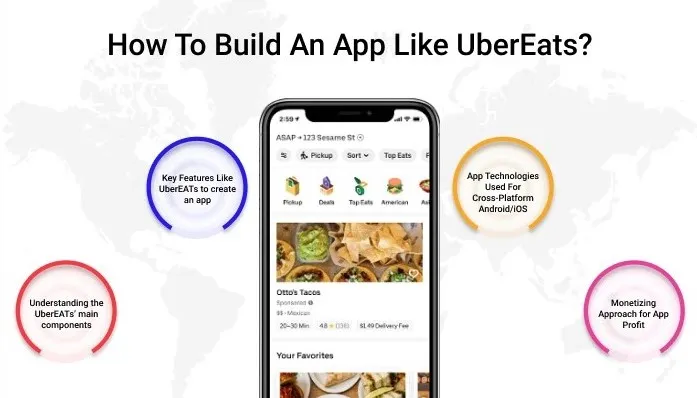The food delivery industry has experienced explosive growth in the past few years, driven by the increasing demand for effortless on-demand services. With platforms such as UberEats and DoorDash transforming the way people request meals, the focus has shifted to developing innovative food delivery apps. These apps provide customers the ability to place orders from their favorite restaurants and have it delivered directly to their location. For businesses, the challenge is to leverage technology to improve delivery logistics and ensure a smooth customer experience.
Building the Perfect Food Delivery App
Creating a profitable food delivery app requires a deep insight of the industry shifts and business models that lead the sector. Whether creating a comprehensive platform or concentrating on niche areas like virtual restaurants or cloud kitchens, the app’s features needs to cater to both customers and restaurants. Essential elements such as order tracking, efficiency improvement, and user satisfaction indicators play a critical role in guaranteeing user retention.
Restaurant Delivery Partnerships: A Winning Strategy
Restaurants are progressively establishing partnerships with delivery platforms to expand their market penetration. These agreements help restaurants cater to a wider customer base while reducing the challenges of running their own delivery services. The effectiveness of such alliances depends on technology integration, which boosts the app usability and enhances the user satisfaction. Through these partnerships, restaurants can boost customer loyalty and ensure that they stay relevant in a saturated market.
How KPIs Drive Food Delivery Profitability
For any enterprise, understanding its key performance indicators (KPIs) is crucial to maintaining financial health. In the food delivery sector, KPIs such as time efficiency, precision in orders, and customer satisfaction are essential. Tracking and improving these KPIs enables delivery services to provide a superior customer experience. Moreover, keeping an focus on financial success aids companies streamline operations, lower charges, and increase overall effectiveness.
Customer Satisfaction and User Retention Strategies
A major factor in the success of delivery apps is their capacity to keep customers through excellent customer service. Providing fast food delivery and resolving customer reviews swiftly can help companies improve their service offerings. Moreover, introducing rewards systems and providing incentives like free delivery can enhance customer loyalty. Customer satisfaction can be additionally strengthened by maintaining food quality control and offering a seamless order management system.
The Role of Technology in Food Delivery
Innovative solutions is at the core of modern food delivery services, helping companies optimize their operations and provide a smooth customer experience. From mobile app development to real-time order monitoring, technology has a significant role in the success of delivery platforms. The use of data analytics to understand customer demographics and preferences allows delivery services to provide customized experiences, furthermore enhancing Food Delivery Market Trends customer interaction.
Competitive Analysis in the Food Delivery Market
The food delivery market is fiercely contested, with many players competing for market share. Conducting a market evaluation allows companies to assess their position in the market and identify opportunities for growth. Delivery platforms must stand out by providing distinctive features such as virtual restaurant options, quick service, or niche cuisine options. Analyzing sector dominance and customer actions empowers companies to tailor their services and stay ahead of the competition.
The Impact of the Pandemic on Food Delivery Services
The COVID-19 pandemic has had a profound impact on the food delivery industry, boosting its expansion as consumers opted for on-demand apps due to social distancing guidelines. The change has emphasized the necessity of technological evolution in the culinary sector, with restaurants rapidly embracing online food ordering and delivery apps. As the world adapts to new normals, food delivery businesses must continue innovating to meet evolving consumer demands and ensure business growth.
Investing in Food Delivery Startups
The food delivery industry presents numerous startup opportunities, with investors keen on backing companies that offer unique solutions. From developing similar platforms to building niche delivery apps, business owners have a range of paths to pursue. Investors seek out strong operation plans and the ability to scale, particularly in areas like delivery network optimization, user experience (UX), and technological advancement. By concentrating on these sectors, startups can secure significant investments and establish themselves in the market.
Enhancing Food Delivery Service Profitability and Expansion
Expanding a food delivery business demands a strong base built on market penetration, pricing strategies, and service differentiation. As regional platforms expand, businesses should focus on creating a reliable delivery network and ensuring quality standards. Furthermore, expanding the menu offerings, forming new collaborations, and integrating advanced technology in food delivery will drive further expansion. By constantly enhancing delivery times and ensuring high user happiness, companies can maintain a competitive edge and increase revenue generation.
These themes provide a complete understanding of the service landscape, with a emphasis on key areas that propel the industry Top Food Delivery Apps forward. Whether whether you are a new company or an experienced business, concentrating on these factors will help you succeed in the challenging world of food delivery.
